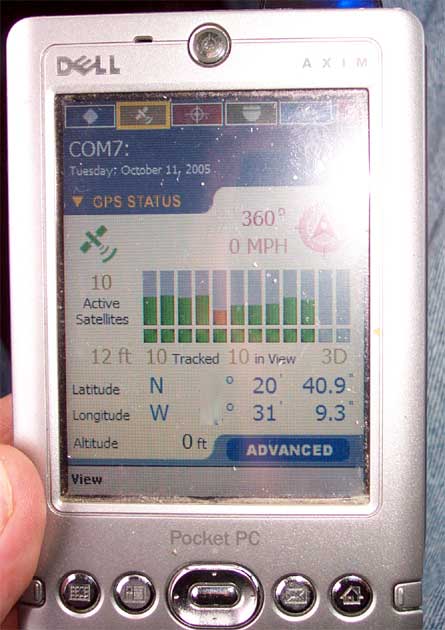Review by kar98 
(Note from the team :Earlier in June 2003 we reviewed the original TomTom BlueTooth receiver. Now , at the same time TomTom launched the version 5 of their software , they also released a new BlueTooth receiver, dubbed the MK II (as in "two"). It is based on the SiRFstar III chipset and a lot of users have asked us for a review on this unit. One of them was even offering to write a review for us - an offer that I just couldn't let pass by)
SirfStarIII and Bluetooth, just flashy marketing gimmicks or worth the money?
"So why should I buy new GPS receiver? I've already got one!", one might ask. But I guess that's just the lot of us early adopters. Last year's
GPS receivers, with the SirfStarII chipset, just aren't good enough anymore, especially if they are of the wired variation.
For the purposes of this exercise, I talked Lutz into handing over his TomTom MkII receiver, and went on a short road trip.
Initial setup of the PDA/receiver combo was a little vexing since my Axim x30 merely pretends to activate Bluetooth on request, yet it still has to be turned on manually, before the GPS program asks for it.
Once that hurdle was taken, a fix was obtained in remarkably short time.
Speaking of "vexing", one of the things that used to make me rip out my hair was the fact that the wired GPS receiver was supposed to be placed
under the windshield, in direct view of the sky, yet not into direct sunlight, excessive heat, or dust.
Oddly enough, that's exactly how I would describe my car dashboard: excessively hot, in direct sun, and dust reigns supreme. Bear in mind that this is Texas we're talking about. The current temperature (October) is 80F, that's 27 Celsius...
So I tried to place the wired receiver closer to the floorboards, into the shade, which created
another couple of problems. Reception went down the drain, and the Y-cable was just too short and prone to tie itself into knots.
Problems, problems, problems. It became so annoying that I was actually /that/ close to give up on the concept of PDA-based navigation,
disregard the notion as mere novelty item and go back to printing Mapquest instructions.
Back to the TomTom MkII. Turn on PDA, activate Bluetooth, turn on the receiver (hold ON/OFF button down for about 3 seconds), start the GPS
navigation software of your choice (the receiver works with other programs just as well, not just TomTom), obtain a fix, enter your target
address, place receiver on the dashboard and since I wasn't driving my own vehicle: stuff PDA into shirt pocket.
"I'll just leave the receiver there on the dash until it locks up, and then I'll put it someplace shady.", I figured.
Well, interestingly enough, the MkII never _did_ lock up, despite the theoretically narrower ranger of operating temperature in the spec sheets (TomTom MkII -10 to +60 degrees Celsius vs. my previous receiver Pharos iGPS-360 -20°C
to 75°C).
But I'm getting ahead of myself. Let's talk about hassle! Or lack thereof. A wired receiver has to have a Y-cable, has to be plugged into cigarette lighter adapter and connected to PDA, which in turn has to be mounted to the dashboard.
Messy, snakes everywhere, wear and tear, and then it still locks up when it gets too hot.
Not so with the combination Bluetooth-enabled PDA and GPS receiver. Just throw the receiver just about anywhere --no open connections, recessed
power button, rounded metal edges, and rubber encased-- have the Pocket PC in your shirt pocket --you're really not supposed to look at the display anyway ;) -- and off you are.
No matter where the receiver slid to, reception never was lost. The least accuracy occurred when the MkII was put under the seat and accuracy dropped to 325 ft. because it only saw a couple of
satellites there.
Yet it still worked. (Tracking sensitivity is-159dBm
TTMkII vs. -140 dBm Pharos iGPS-360).
In general, the fix was never lost and accuracy never slipped under 30 feet during normal usage.
This despite the fact that WAAS is not enabled on the MkII. The 20-channel chipset (6 to 10 satellites typically in view) more than makes up for the missing WAAS, in comparison to the iGPS-360, which typically saw only 4 to 6 satellites at any given time.

12 ft accuracy, and all without WAAS. That's sitting in the car, parked towards a wall, btw.
Since the Mk2 can be run for at least 10 hrs without any wires connected
to anything, placing it in a pair of Ziploc baggies to make it
waterproof worked very well travelling around New Orleans.
Basically, Bluetooth-enabled SirfStarIII receivers are easily a couple of lightyears ahead of the archaic, stone-age wired SirfStarII devices.
The TomTom Mk2 in particular beats the iGPS-360, which by the way is also sold under the Microsoft brand, into oblivion. I'd even feel bad /giving/ the latter away to some unsuspecting soul.
The only thing I'd really have to criticize about the TomTom Mk2 is that there is no way to adjust the time for the automatic powering off of the
receiver when it doesn't move for a few minutes.
Think deliveries being unloaded and signed for, or a traffic jam or things like that. Basically situations that may have prompted you to get into GPS navigation in the first place.
Thanks to the diminuitive form factor --about the size of an expensive
lighter--, the MkII fits into your jeans pockets just fine, where no
sharp painful edges will assault the unsuspecting driver. Although I
haven't been able to figure out the reason for the oblong hole in the
receiver. To put it on a keyring?
|